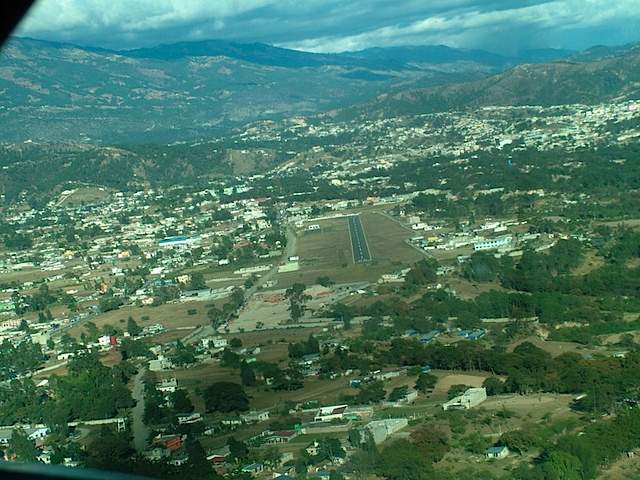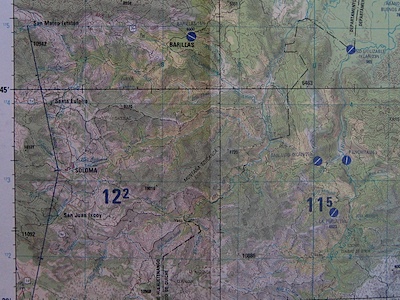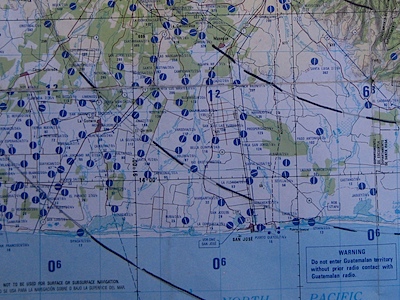
I mentioned in passing a few weeks back that my inlaws had hitched a ride with a local bush pilot. I didn’t say more at the time, because I am a big aviation buff and I felt the topic deserved its own discussion.
Emily and I have always felt that part of our job as PCVs is to network and make connections on behalf of our villagers. The old saw “it’s not what you know, it’s who you know” is proven true time and time again in Guatemala, as we travel to meet with NGOs, aid workers, and anyone we can. Many of these meetings are fruitless, but it pays off often enough to make it worthwhile… like the MAGA and chicken vaccinations, computers for the local high schoolers, materials for the midwives, books for the elementary school, scholarships for the girls, support for the new teachers’ institute, the list goes on. The villagers recognized this opportunity the day we arrived; when you bring a gringo into your village, you bring the whole gringo network.
And it’s in this manner that we met Jason Patton. He is an American pilot who (amongst other things) flies aid workers into remote parts of Guatemala. Mike, my father-in-law, contacted him about a flight from Guatemala City to Huehuetenango. This would turn a hard 5-hour chicken bus ride into a pleasant 40-minute sightseeing tour.
Emily and I took our own chicken bus to the airstrip in Huehue to meet them. Within minutes of the appointed time, a bright red and white airplane came roaring overhead in a low pass to check the wind sock, and a few minutes after that, it was sitting on the tarmac in front of us, propeller clicking to a standstill.
Jason’s airplane is a Maule M-5 Rocket. It’s an 80’s model (relatively new for an airplane), and in great shape. It’s a four-place taildragger, and this particular one sports a lot of special modifications, like a stormscope, extra radios, ILS receiver, extended range tanks, and vortex generators on the wings. I think I saw an iPod stuck to the panel, too. And, like all the Maule aircraft, it can get off the ground in just a few hundred feet. It’s totally sweet.
Mike and I both wanted to invite Jason to dinner, but he mentioned that if he stayed, he’d have to spend the night. Night flying in Guatemala is illegal unless you are on an international flight plan, since the mountains are so high and devoid of electric lights. It took us about two seconds to decide we needed to buy him a hotel room.
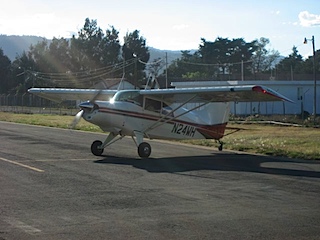 At dinner, we had a chance to probe him about what he does in Guatemala. Jason and his wife started an NGO called Lifebuilders International. They primarily work as missionaries, which I must admit, made me wary. I am not a religious man myself, and I have seen some evil done in the name of “converting the pagans”. But Jason is a cool, reasonable fellow and is totally unafflicted by the proselytizing rhetoric and biblical manner of speaking that I have occasionally encountered amongst religiously-affiliated aid workers. Instead, he spoke about many of the same issues that concern us as Peace Corps volunteers: sustainability in development, corruption and mismanagement, the basic goodness of the Guatemalan people, even the silly trials of daily living as an aid worker. He struck me as very honest, human, and REAL. I don’t know if it’s his interest in aviation, his friendly midwest demeanor, or the fact that he’s the same age as me, but after an hour I felt like I’d known him for years.
At dinner, we had a chance to probe him about what he does in Guatemala. Jason and his wife started an NGO called Lifebuilders International. They primarily work as missionaries, which I must admit, made me wary. I am not a religious man myself, and I have seen some evil done in the name of “converting the pagans”. But Jason is a cool, reasonable fellow and is totally unafflicted by the proselytizing rhetoric and biblical manner of speaking that I have occasionally encountered amongst religiously-affiliated aid workers. Instead, he spoke about many of the same issues that concern us as Peace Corps volunteers: sustainability in development, corruption and mismanagement, the basic goodness of the Guatemalan people, even the silly trials of daily living as an aid worker. He struck me as very honest, human, and REAL. I don’t know if it’s his interest in aviation, his friendly midwest demeanor, or the fact that he’s the same age as me, but after an hour I felt like I’d known him for years. 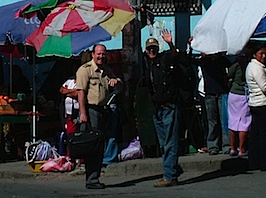
Once I gave him the secret pilot handshake, we started talking about aviation and it didn’t stop until he left the next day. I told him that I am an instrument rated pilot, though my Peace Corps salary has kept me earthbound for over two years. He worked a professional pilot and a flight instructor in the US for a while, and in addition to being an airframe & powerplant mechanic, he has been bushflying in Guatemala for about seven years. After dinner, we returned to the hotel and he got out his pilot’s bag.
“I found these at an airshow a while back, and bought the lot,” he said, pulling out some aerial navigation charts. They looked a lot like the sectional charts we have in the US, but were labeled Joint Operations Graphics. Produced by the same department of the US government, these were from the 80s, and bore a conspicuous red “DECLASSIFIED” stamp.
“I called the government to see if I could get more up-to-date versions, and they told me that the current ones are classified.” But the old ones still have their utility, as they show airfields that WERE there in the 80s. One of Jason’s other jobs is airfield restoration, and these old maps help him find airstrips that would otherwise be impossible to locate. “I found one that hadn’t been used in a while near one of our mission sites, and the villagers and I had to spend weeks clearing 3-inch-thick saplings before I could fly into it.”
For kicks, we looked at airfield availability within several hours of my village. Besides a barely-useable field near Barillas (3 hours away), there’s nothing. This is a strong contrast to the south coast of Guatemala, which is littered with airstrips. “It’s because of the plantations,” Jason explained. “Back in the day, plantation owners would fly in to inspect their vast holdings, then fly out.” In the north, however, there’s nothing to interest fat-cat businessmen: just Mayans and mountains.
Besides ferrying aid workers into remote airstrips, Jason is also setting up a farm/orphanage near Lake Atitlán. That’s part of how Mike got hooked up with him in the first place: he’s looking for a large tiller, and someone in Mike’s Rotary club has a lead on one. We talked about the work I’m doing with greenhouses and biointensive gardening and his work with solar water heating. If I get the chance, I am going to visit his farm and see how we can help each other. Who knows, maybe something else good will happen as a result?
